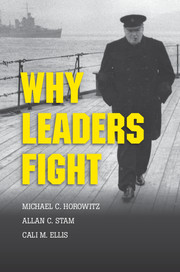Book contents
- Frontmatter
- Contents
- List of Figures
- List of Photographs
- List of Tables
- Preface
- Introduction
- 1 How Leaders Matter
- 2 Systematically Evaluating Leader Risk
- 3 Leader Risk across Geography and Time
- 4 The Experiences That Matter I: Military/Rebel Status, Age, and Education
- 5 The Experiences That Matter II: Childhood, Family, and Gender
- 6 “L’état, c'est moi” – or Is It?
- Bibliography
- Index
3 - Leader Risk across Geography and Time
Published online by Cambridge University Press: 05 October 2015
- Frontmatter
- Contents
- List of Figures
- List of Photographs
- List of Tables
- Preface
- Introduction
- 1 How Leaders Matter
- 2 Systematically Evaluating Leader Risk
- 3 Leader Risk across Geography and Time
- 4 The Experiences That Matter I: Military/Rebel Status, Age, and Education
- 5 The Experiences That Matter II: Childhood, Family, and Gender
- 6 “L’état, c'est moi” – or Is It?
- Bibliography
- Index
Summary
How important are leader attributes, compared with the predictions of system-level theories, when it comes to the outbreak of international conflict? The previous chapter began the process of systematically examining the importance of leaders by describing the creation of an index of leader risk that measures, based on the background experiences of leaders, their propensity to start international conflicts.
This chapter compares the Leader Risk Index to more traditional explanations for warfare. It maps conflict across the world, as well as across specific regions, from 1875 to 2001, to highlight the importance of understanding leader risk. Using advanced statistical models, the results in this chapter show that while the effects of leaders are almost certainly influenced by the relative power of their countries and the domestic political contexts in which they operate, leaders still exercise independent influence over international politics.
Mapping Leader Risk
The empirical literature on war outbreak and escalation provides strong evidence for the importance of analysis at the regional level. International relations theory acknowledges the fundamental importance of geography as a risk factor either mitigating or exacerbating the risks of interstate war. John Mearsheimer notes the “stopping power of water,” for example, that makes it difficult to project power across oceans even for the most powerful countries in the world. Mountains, rivers, and swamps make for relatively stable national borders because they greatly increase the difficulty of projecting military power. States such as Poland, with borders lacking natural defenses, have been among the most frequently conquered. One of the strongest findings from empirical research on international conflict, not surprisingly, is that contiguous neighbors are more likely to fight, whether the disputes are related to territory, revenge for past grievances, or ethnic conflict.
In attempting to understand the role of leaders in shaping the distribution of international conflict more generally, one approach is to look at particular regions and the distribution, or lack thereof, of conflict-prone leaders. Figure 3.1 shows a global risk map for leaders in office in 1989, at the end of the Cold War.
In this map and the ones that follow, the color corresponds to the risk level associated with each country's leader. Compare the leader-risk data in Figure 3.1 with the same map based solely on the same “system” level models of international conflict used in Chapter 2, in Figure 3.2.
- Type
- Chapter
- Information
- Why Leaders Fight , pp. 93 - 128Publisher: Cambridge University PressPrint publication year: 2015



